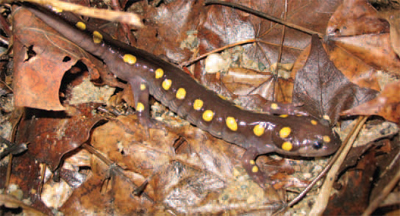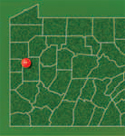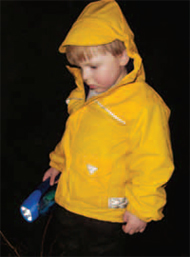Wildlife-Watchers’ Bliss
Wolf Creek Narrows
Most people know Wolf Creek Narrows for its amazing displays of spring wildflowers. Less well-known are its vernal pools – small, temporary ponds that fill with water in the winter and spring and dry out each summer. Because they dry out, fish can’t live in them, and this makes them the right habitat for a number of animal species.
The most secretive of these species are spotted salamanders. A very well-timed visit to Wolf Creek Narrows during a rainy night in the early spring may be rewarded by seeing salamanders walking to the pools from the surrounding forests, or swimming in the pools. Choosing the right night is tricky, but the migration usually happens sometime in March.

Nighttime visitors to Wolf Creek Narrows may see spotted salamanders.
“The first time I went to the pools at Wolf Creek Narrows with my three-year-old son, we were there a bit too early in the year and we saw only a single salamander, but that was fine with my son,” said WPC Ecologist Peter Woods. “Just the adventure of a nighttime walk in the rainy woods was terribly exciting, and to find a six-inch-long creature with bright yellow spots made the trip magical.”

Spotted salamanders spend most of the year in the upland forest, burrowing under logs and in leaf mold, where they are almost never seen by people. They come to the pools for only a few days each year to breed, during the warm, rainy nights of spring. The darkness protects them from predators and the rain protects their sensitive skin from drying out. After they mate and lay eggs in the pools, they travel back to their upland habitats on the next rainy night.
To select the right night to see salamanders, Woods advises, “Watch the soil – the salamanders won’t move until it thaws – and then watch the weather forecast for a warm rain at night. The right conditions will bring dozens of salamanders to the pools.”
Other vernal pool breeders include wood frogs and fairy shrimp. Wood frogs, too, travel to the pools just for breeding, but unlike the silent salamanders, their duck-like calls can be heard from some distance away.

Three-year-old Finn Woods searches for vernal pool dwellers.
Fairy shrimp stay in the pools for their entire lives. Up to one inch long, these tiny crustaceans can be seen swimming belly-side up in the deeper parts of the pools. Hatching even before the ice melts off the pool, they complete their whole life cycle and lay eggs before the pool dries up. “Their eggs dry up when the pool does, but remain viable for years, waiting for the pool to fill with water again,” said Woods.
If you miss the salamanders themselves, you can still see their egg masses for several weeks after they have left the pools. These fist-sized gelatinous clumps can contain up to a few hundred eggs, and you can see the developing embryo inside each egg. Wood frog egg masses are like those of the salamanders, but are more loosely held together.
Even during a daytime visit to Wolf Creek Narrows for the early spring wildflowers, egg masses of both salamanders and wood frogs may be seen. At this time of year, visitors also may spot the rare West Virginia White butterfly drinking nectar from the spring beauties and other flowers on the slopes around the pool.
Directions: From Slippery Rock, take West Water Street for a
mile and a half. Cross the bridge and park in the lot on the left
side. From the parking lot on the north side of the creek, cross
the bridge and find the trailhead at the north side of the road.
Follow the trail along the floodplain. You will see a number of
pools along the floodplain, but the most reliable one for seeing
the vernal pool breeders is uphill from these, on the upper
terrace of the floodplain. Watch for a place where the trail
splits, and one branch goes away from the creek, across a
small footbridge and up the slope. Where the trail levels out
again on a terrace, look to your right and you will see the pool.
If you haven’t been to the pool before, please get familiar with
the path in the daytime before attempting to go there at night.
GPS coordinates: -80.08860 41.06691
Continue reading about "Wildlife-Watchers' Bliss" with Enlow Fork.
